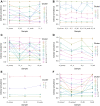Multi-Region Genomic Landscape Analysis for the Preoperative Prediction of Lymph Node Metastasis in Esophageal Carcinoma
- PMID: 35401692
- PMCID: PMC8986126
- DOI: 10.3389/fgene.2022.830601
Multi-Region Genomic Landscape Analysis for the Preoperative Prediction of Lymph Node Metastasis in Esophageal Carcinoma
Abstract
Objective: Esophageal cancer is an aggressive malignant tumor, with 90 percent of the patients prone to recurrence and metastasis. Although recent studies have identified some potential biomarkers, these biomarkers' clinical or pathological significance is still unclear. Therefore, it is urgent to further identify and study novel molecular changes occurring in esophageal cancer. It has positive clinical significance to identify a tumor-specific mutation in patients after surgery for an effective intervention to improve the prognosis of patients. Methods: In this study, we performed whole-exome sequencing (WES) on 33 tissue samples from six esophageal cancer patients with lymph node metastasis, compared the differences in the genomic and evolutionary maps in different tissues, and then performed pathway enrichment analysis on non-synonymous mutation genes. Finally, we sorted out the somatic mutation data of all patients to analyze the subclonality of each tumor. Results: There were significant differences in somatic mutations between the metastatic lymph nodes and primary lesions in the six patients. Clustering results of pathway enrichment analysis indicated that the metastatic lymph nodes had certain commonalities. Tumors of the cloned exploration results illustrated that five patients showed substantial heterogeneity. Conclusion: WES technology can be used to explore the differences in regional evolutionary maps, heterogeneity, and detect patients' tumor-specific mutations. In addition, an in-depth understanding of the ontogeny and phylogeny of tumor heterogeneity can help to further find new molecular changes in esophageal cancer, which can improve the prognosis of EC patients and provide a valuable reference for their diagnosis.
Keywords: esophageal carcinoma; lymph node metastases; multi-region sequencing; subclone; whole-exome sequencing.
Copyright © 2022 Lin, Chen, Wang, Cai, Chen, Chen, Shi, Chen and Zhu.
Conflict of interest statement
The authors declare that the research was conducted in the absence of any commercial or financial relationships that could be construed as a potential conflict of interest. The reviewer (LF) declared a past co-authorship with the author (GC) to the handling editor.
Figures





Similar articles
-
Mutation landscape and intra-tumor heterogeneity of two MANECs of the esophagus revealed by multi-region sequencing.Oncotarget. 2017 Jun 27;8(41):69610-69621. doi: 10.18632/oncotarget.18678. eCollection 2017 Sep 19. Oncotarget. 2017. PMID: 29050228 Free PMC article.
-
[Analysis of lymph node metastases of 217 cases of thoracic esophageal carcinoma and its impact on prognosis].Ai Zheng. 2003 Sep;22(9):974-7. Ai Zheng. 2003. PMID: 12969532 Chinese.
-
[Multiregion sequencing reveals intratumor heterogeneity in esophageal squamous cell carcinoma].Zhonghua Zhong Liu Za Zhi. 2016 Sep 23;38(9):660-6. doi: 10.3760/cma.j.issn.0253-3766.2016.09.005. Zhonghua Zhong Liu Za Zhi. 2016. PMID: 27647397 Chinese.
-
Genetic and immune characteristics of sentinel lymph node metastases and multiple lymph node metastases compared to their matched primary breast tumours.EBioMedicine. 2021 Sep;71:103542. doi: 10.1016/j.ebiom.2021.103542. Epub 2021 Aug 26. EBioMedicine. 2021. PMID: 34454403 Free PMC article.
-
Clonal evolution of esophageal squamous cell carcinoma from normal mucosa to primary tumor and metastases.Carcinogenesis. 2019 Dec 31;40(12):1445-1451. doi: 10.1093/carcin/bgz162. Carcinogenesis. 2019. PMID: 31570939
Cited by
-
Lymphatic Metastasis of Esophageal Squamous Cell Carcinoma: The Role of NRF2 and Therapeutic Strategies.Cancers (Basel). 2025 May 31;17(11):1853. doi: 10.3390/cancers17111853. Cancers (Basel). 2025. PMID: 40507333 Free PMC article. Review.
References
-
- Alderson D., Langley R. E., Nankivell M. G., Blazeby J. M., Griffin M., Crellin A., et al. (2015). Neoadjuvant Chemotherapy for Resectable Oesophageal and Junctional Adenocarcinoma: Results from the UK Medical Research Council Randomised OEO5 Trial (ISRCTN 01852072). J. Clin. Oncol. 33 (15_Suppl. l), 4002. 10.1200/jco.2015.33.15_suppl.4002 - DOI
LinkOut - more resources
Full Text Sources

